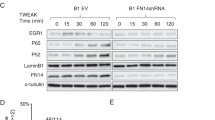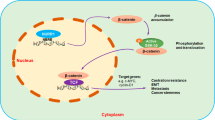Abstract
Overexpression of the Ron receptor tyrosine kinase has recently been shown in a wide variety of human cancers. However, no studies have examined Ron receptor expression or function during prostate tumorigenesis. In this study we report that Ron is highly expressed in human prostate adenocarcinoma and metastatic lymph nodes when compared with normal prostate or benign prostate hyperplasia. Furthermore, we show that Ron is overexpressed in PC-3 and DU145 prostate cancer cell lines, and that the levels of angiogenic chemokines produced by prostate cancer cells positively correlate with Ron expression. The knockdown of Ron in PC-3 or DU145 cells results in a significant decrease in angiogenic chemokine production and is associated with a decreased activation of the transcription factor nuclear factor-κB (NF-κB). Moreover, exogenous overexpression of Ron in LNCaP cells is sufficient to induce a significant increase in angiogenic chemokines that can be abrogated by inhibition of NF-κB signaling. Given that the function of angiogenic chemokines is important in the development of new blood vessels, we also examined the ability of Ron to modulate endothelial cell migration. Our data show that knockdown of Ron in prostate cancer cells results in significantly less endothelial cell chemotaxis when compared with Ron-expressing cells in vitro as well as in reduced tumor growth and decreased microvessel density after orthotopic transplantation into the prostate in vivo. In total, our data suggest that the Ron receptor is important in modulating prostate tumor growth by modulating angiogenic chemokine production and subsequent endothelial cell recruitment.
This is a preview of subscription content, access via your institution
Access options
Subscribe to this journal
Receive 50 print issues and online access
$259.00 per year
only $5.18 per issue
Buy this article
- Purchase on Springer Link
- Instant access to full article PDF
Prices may be subject to local taxes which are calculated during checkout







Similar content being viewed by others
References
Addison CL, Daniel TO, Burdick MD, Liu H, Ehlert JE, Xue YY et al. (2000). The CXC chemokine receptor 2, CXCR2, is the putative receptor for ELR+ CXC chemokine-induced angiogenic activity. J Immunol 165: 5269–5277.
Balbay MD, Pettaway CA, Kuniyasu H, Inoue K, Ramirez E, Li E et al. (1999). Highly metastatic human prostate cancer growing within the prostate of athymic mice overexpresses vascular endothelial growth factor. Clin Cancer Res 5: 783–789.
Best CJ, Gillespie JW, Yi Y, Chandramouli GV, Perlmutter MA, Gathright Y et al. (2005). Molecular alterations in primary prostate cancer after androgen ablation therapy. Clin Cancer Res 11: 6823–6834.
Bezerra JA, Carrick TL, Degen JL, Witte D, Degen SJ . (1998). Biological effects of targeted inactivation of hepatocyte growth factor-like protein in mice. J Clin Invest 101: 1175–1183.
Bezerra JA, Witte DP, Aronow BJ, Degen SJ . (1993). Hepatocyte-specific expression of the mouse hepatocyte growth factor-like protein. Hepatology 18: 394–399.
Chen YQ, Zhou YQ, Angeloni D, Kurtz AL, Qiang XZ, Wang MH . (2000). Overexpression and activation of the RON receptor tyrosine kinase in a panel of human colorectal carcinoma cell lines. Exp Cell Res 261: 229–238.
Collado B, Carmena MJ, Clemente C, Prieto JC, Bajo AM . (2007). Vasoactive intestinal peptide enhances growth and angiogenesis of human experimental prostate cancer in a xenograft model. Peptides 28: 1896–1901.
Craft PS, Harris AL . (1994). Clinical prognostic significance of tumour angiogenesis. Ann Oncol 5: 305–311.
Dhanasekaran SM, Dash A, Yu J, Maine IP, Laxman B, Tomlins SA et al. (2005). Molecular profiling of human prostate tissues: insights into gene expression patterns of prostate development during puberty. FASEB J 19: 243–245.
Greene GF, Kitadai Y, Pettaway CA, von Eschenbach AC, Bucana CD, Fidler IJ . (1997). Correlation of metastasis-related gene expression with metastatic potential in human prostate carcinoma cells implanted in nude mice using an in situ messenger RNA hybridization technique. Am J Pathol 150: 1571–1582.
Hepburn PJ, Griffiths K, Harper ME . (1997). Angiogenic factors expressed by human prostatic cell lines: effect on endothelial cell growth in vitro. Prostate 33: 123–132.
Jimenez JA, Kao C, Raikwar S, Gardner TA . (2006). Current status of anti-angiogenesis therapy for prostate cancer. Urol Oncol 24: 260–268.
Keeley EC, Mehrad B, Strieter RM . (2008). Chemokines as mediators of neovascularization. Arterioscler Thromb Vasc Biol 28: 1928–1936.
Koch AE, Polverini PJ, Kunkel SL, Harlow LA, DiPietro LA, Elner VM et al. (1992). Interleukin-8 as a macrophage-derived mediator of angiogenesis. Science 258: 1798–1801.
Lapointe J, Li C, Giacomini CP, Salari K, Huang S, Wang P et al. (2007). Genomic profiling reveals alternative genetic pathways of prostate tumorigenesis. Cancer Res 67: 8504–8510.
Leonis MA, Thobe MN, Waltz SE . (2007). Ron-receptor tyrosine kinase in tumorigenesis and metastasis. Future Oncol 3: 441–448.
Li Y, Jin Y, Chen H, Jie G, Tobelem G, Caen JP et al. (2003). Suppression of tumor growth by viral vector-mediated gene transfer of N-terminal truncated platelet factor 4. Cancer Biother Radiopharm 18: 829–840.
Lissbrant IF, Stattin P, Damber JE, Bergh A . (1997). Vascular density is a predictor of cancer-specific survival in prostatic carcinoma. Prostate 33: 38–45.
Loh SA, Chang EI, Galvez MG, Thangarajah H, El-ftesi S, Vial IN et al. (2009). SDF-1 alpha expression during wound healing in the aged is HIF dependent. Plast Reconstr Surg 123: 65S–75S.
Maggiora P, Marchio S, Stella MC, Giai M, Belfiore A, De Bortoli M et al. (1998). Overexpression of the RON gene in human breast carcinoma. Oncogene 16: 2927–2933.
Moore BB, Arenberg DA, Stoy K, Morgan T, Addison CL, Morris SB et al. (1999). Distinct CXC chemokines mediate tumorigenicity of prostate cancer cells. Am J Pathol 154: 1503–1512.
Nikolaidis NM, Gray JK, Gurusamy D, Fox W, Stuart WD, Huber N et al. (2009). Ron receptor tyrosine kinase negatively regulates TNFalpha production in alveolar macrophages by inhibiting NF-kappaB activity and ADAM17 production. Shock (in press).
O'Toole JM, Rabenau KE, Burns K, Lu D, Mangalampalli V, Balderes P et al. (2006). Therapeutic implications of a human neutralizing antibody to the macrophage-stimulating protein receptor tyrosine kinase (RON), a c-MET family member. Cancer Res 66: 9162–9170.
Peace BE, Hughes MJ, Degen SJ, Waltz SE . (2001). Point mutations and overexpression of Ron induce transformation, tumor formation, and metastasis. Oncogene 20: 6142–6151.
Peace BE, Toney-Earley K, Collins MH, Waltz SE . (2005). Ron receptor signaling augments mammary tumor formation and metastasis in a murine model of breast cancer. Cancer Res 65: 1285–1293.
Pound CR, Partin AW, Eisenberger MA, Chan DW, Pearson JD, Walsh PC . (1999). Natural history of progression after PSA elevation following radical prostatectomy. JAMA 281: 1591–1597.
Puri N, Khramtsov A, Ahmed S, Nallasura V, Hetzel JT, Jagadeeswaran R et al. (2007). A selective small molecule inhibitor of c-Met, PHA665752, inhibits tumorigenicity and angiogenesis in mouse lung cancer xenografts. Cancer Res 67: 3529–3534.
Ren Y, Cao B, Law S, Xie Y, Lee PY, Cheung L et al. (2005). Hepatocyte growth factor promotes cancer cell migration and angiogenic factors expression: a prognostic marker of human esophageal squamous cell carcinomas. Clin Cancer Res 11: 6190–6197.
Rollins BJ . (1997). Chemokines. Blood 90: 909–928.
Salcedo R, Resau JH, Halverson D, Hudson EA, Dambach M, Powell D et al. (2000). Differential expression and responsiveness of chemokine receptors (CXCR1-3) by human microvascular endothelial cells and umbilical vein endothelial cells. FASEB J 14: 2055–2064.
Sawa Y, Tsuruga E, Iwasawa K, Ishikawa H, Yoshida S . (2008). Leukocyte adhesion molecule and chemokine production through lipoteichoic acid recognition by toll-like receptor 2 in cultured human lymphatic endothelium. Cell Tissue Res 333: 237–252.
Shen H, Lentsch AB . (2004). Progressive dysregulation of transcription factors NF-kappa B and STAT1 in prostate cancer cells causes proangiogenic production of CXC chemokines. Am J Physiol Cell Physiol 286: C840–C847.
Shen H, Schuster R, Stringer KF, Waltz SE, Lentsch AB . (2006). The Duffy antigen/receptor for chemokines (DARC) regulates prostate tumor growth. FASEB J 20: 59–64.
Strieter RM, Burdick MD, Mestas J, Gomperts B, Keane MP, Belperio JA . (2006). Cancer CXC chemokine networks and tumour angiogenesis. Eur J Cancer 42: 768–778.
Thomas RM, Toney K, Fenoglio-Preiser C, Revelo-Penafiel MP, Hingorani SR, Tuveson DA et al. (2007). The RON receptor tyrosine kinase mediates oncogenic phenotypes in pancreatic cancer cells and is increasingly expressed during pancreatic cancer progression. Cancer Res 67: 6075–6082.
Tomlins SA, Mehra R, Rhodes DR, Cao X, Wang L, Dhanasekaran SM et al. (2007). Integrative molecular concept modeling of prostate cancer progression. Nat Genet 39: 41–51.
Varambally S, Yu J, Laxman B, Rhodes DR, Mehra R, Tomlins SA et al. (2005). Integrative genomic and proteomic analysis of prostate cancer reveals signatures of metastatic progression. Cancer Cell 8: 393–406.
Verras M, Lee J, Xue H, Li TH, Wang Y, Sun Z . (2007). The androgen receptor negatively regulates the expression of c-Met: implications for a novel mechanism of prostate cancer progression. Cancer Res 67: 967–975.
Wagh PK, Peace BE, Waltz SE . (2008). Met-related receptor tyrosine kinase Ron in tumor growth and metastasis. Adv Cancer Res 100: 1–33.
Wang MH, Lee W, Luo YL, Weis MT, Yao HP . (2007). Altered expression of the RON receptor tyrosine kinase in various epithelial cancers and its contribution to tumourigenic phenotypes in thyroid cancer cells. J Pathol 213: 402–411.
Waugh DJ, Wilson C, Seaton A, Maxwell PJ . (2008). Multi-faceted roles for CXC-chemokines in prostate cancer progression. Front Biosci 13: 4595–4604.
Welm AL, Sneddon JB, Taylor C, Nuyten DS, van de Vijver MJ, Hasegawa BH et al. (2007). The macrophage-stimulating protein pathway promotes metastasis in a mouse model for breast cancer and predicts poor prognosis in humans. Proc Natl Acad Sci USA 104: 7570–7575.
Wilson C, Purcell C, Seaton A, Oladipo O, Maxwell PJ, O'Sullivan JM et al. (2008). Chemotherapy-induced CXC-chemokine/CXC-chemokine receptor signaling in metastatic prostate cancer cells confers resistance to oxaliplatin through potentiation of nuclear factor-kappaB transcription and evasion of apoptosis. J Pharmacol Exp Ther 327: 746–759.
Yoshida S, Harada T, Iwabe T, Taniguchi F, Fujii A, Sakamoto Y et al. (2002). Induction of hepatocyte growth factor in stromal cells by tumor-derived basic fibroblast growth factor enhances growth and invasion of endometrial cancer. J Clin Endocrinol Metab 87: 2376–2383.
Zhou YQ, He C, Chen YQ, Wang D, Wang MH . (2003). Altered expression of the RON receptor tyrosine kinase in primary human colorectal adenocarcinomas: generation of different splicing RON variants and their oncogenic potential. Oncogene 22: 186–197.
Zinser GM, Leonis MA, Toney K, Pathrose P, Thobe M, Kader SA et al. (2006). Mammary-specific Ron receptor overexpression induces highly metastatic mammary tumors associated with beta-catenin activation. Cancer Res 66: 11967–11974.
Acknowledgements
We thank Sandy Schwemberger for her assistance with the flow cytometry experiments as well as Sarah Kader for her technical contributions. This work was supported by Public Health Services Grants CA-125370 (SEW) from the National Institutes of Health, and by grant project no. PC060821 (MNT) from the Department of Defense Congressionally Directed Medical Research Programs.
Author information
Authors and Affiliations
Corresponding author
Additional information
Supplementary Information accompanies the paper on the Oncogene website (http://www.nature.com/onc)
Supplementary information
Rights and permissions
About this article
Cite this article
Thobe, M., Gurusamy, D., Pathrose, P. et al. The Ron receptor tyrosine kinase positively regulates angiogenic chemokine production in prostate cancer cells. Oncogene 29, 214–226 (2010). https://doi.org/10.1038/onc.2009.331
Received:
Revised:
Accepted:
Published:
Issue Date:
DOI: https://doi.org/10.1038/onc.2009.331
Keywords
This article is cited by
-
A network map of macrophage-stimulating protein (MSP) signaling
Journal of Cell Communication and Signaling (2023)
-
MST1R (RON) expression is a novel prognostic biomarker for metastatic progression in breast cancer patients
Breast Cancer Research and Treatment (2020)
-
MST1R kinase accelerates pancreatic cancer progression via effects on both epithelial cells and macrophages
Oncogene (2019)
-
The Ron receptor tyrosine kinase activates c-Abl to promote cell proliferation through tyrosine phosphorylation of PCNA in breast cancer
Oncogene (2014)
-
MSP–RON signalling in cancer: pathogenesis and therapeutic potential
Nature Reviews Cancer (2013)



